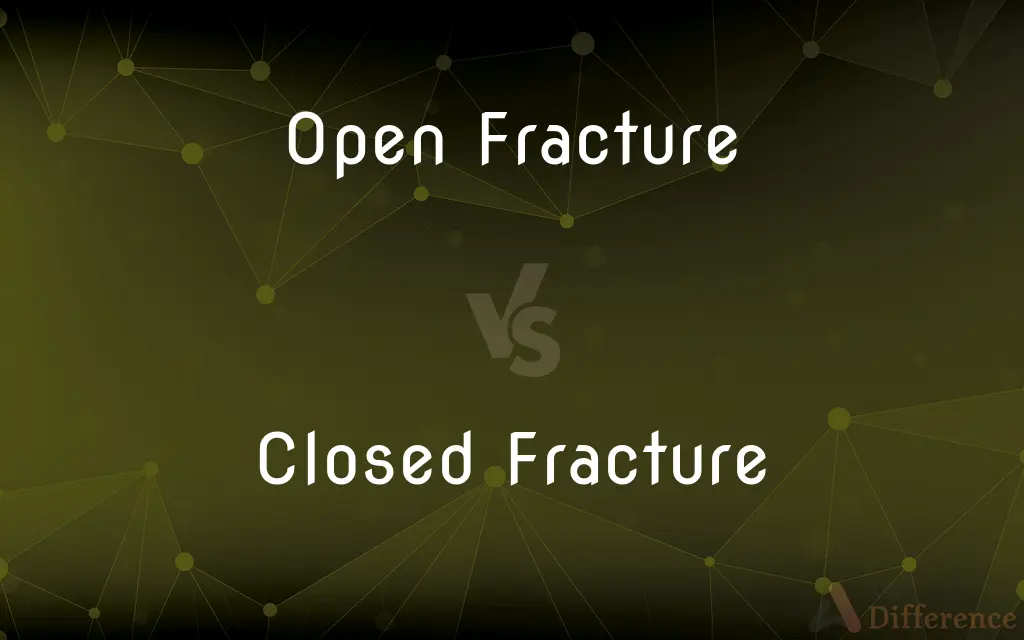Open Fracture vs. Closed Fracture — What's the Difference?
By Tayyaba Rehman — Published on January 29, 2024
Open Fracture: bone breaks and pierces the skin. Closed Fracture: bone breaks but skin remains intact.

Difference Between Open Fracture and Closed Fracture
Table of Contents
ADVERTISEMENT
Key Differences
An Open Fracture, also known as a compound fracture, occurs when a broken bone pierces through the skin, creating an open wound. This type of fracture is generally more severe due to the risk of infection. In contrast, a Closed Fracture refers to a situation where the bone breaks but does not disrupt the skin, thus keeping the fracture site contained within the body.
Open Fractures are often associated with higher complication rates, including the possibility of infection and longer healing times, due to the exposure of the bone to the external environment. Closed Fractures, while still serious, typically have a lower risk of infection since the skin barrier remains intact, protecting the fracture site from external contaminants.
Treatment for an Open Fracture usually involves more immediate and aggressive intervention, such as surgical cleaning and stabilization, to prevent infection and properly align the bone. Closed Fractures might also require surgery, depending on the severity, but the initial focus is often on immobilization and pain management.
The causes of Open Fractures often involve high-impact trauma or accidents, making them more common in situations like vehicle accidents or falls from a height. Closed Fractures can occur from similar traumas but are also commonly seen in sports injuries, falls, or minor accidents where the force is not enough to break the skin.
Recovery from an Open Fracture can be more complicated and prolonged due to the potential for infections and the need for more complex medical interventions. Closed Fractures, depending on their severity, generally have a more straightforward recovery process, although this can vary based on the specific bone and type of break.
ADVERTISEMENT
Comparison Chart
Skin Condition
Breaks the skin
Skin remains intact
Risk of Infection
Higher risk due to exposure
Lower risk, skin acts as a barrier
Typical Causes
High-impact trauma, accidents
Varies, includes minor accidents
Treatment
Often requires surgery, risk of infection
May or may not need surgery, focus on immobilization
Recovery Process
Generally more complicated and longer
Usually simpler and quicker
Compare with Definitions
Open Fracture
Characterized by visible bone and an open wound.
The open fracture was immediately visible due to the protruding bone.
Closed Fracture
A fracture where the bone breaks but the skin is not pierced.
She has a closed fracture in her arm from the fall.
Open Fracture
Requires urgent medical attention to prevent infection.
An open fracture needs immediate surgery to clean the wound.
Closed Fracture
The broken bone is contained within the skin.
The X-ray showed a closed fracture with no skin damage.
Open Fracture
More complex to treat due to the risk of complications.
Treating his open fracture involved both orthopedic and plastic surgery.
Closed Fracture
Can range from minor to severe breaks.
The ski accident caused a severe closed fracture in his knee.
Open Fracture
A fracture where the bone breaks and pierces the skin.
The patient suffered an open fracture in the car crash.
Closed Fracture
Lower risk of infection compared to open fractures.
Fortunately, the closed fracture minimized the infection risk.
Open Fracture
Often associated with severe injuries and trauma.
The high-impact fall resulted in an open fracture of the leg.
Closed Fracture
Treatment may involve immobilization or surgery.
His closed fracture was treated with a cast for six weeks.
Common Curiosities
What's the usual treatment for a Closed Fracture?
Closed Fractures typically require immobilization, such as with a cast or splint, and sometimes surgery.
What defines an Open Fracture?
An Open Fracture occurs when a bone break results in an open wound with the bone piercing the skin.
What is a Closed Fracture?
A Closed Fracture is where the bone breaks but does not penetrate through the skin.
How are Open Fractures treated?
Treatment often involves surgery, wound cleaning, and antibiotics to prevent infection.
Which is more severe: Open or Closed Fracture?
Open Fractures are generally more severe due to the risk of infection and complexity of the injury.
How do Closed Fractures typically occur?
They can occur from various impacts, including falls, sports injuries, or minor accidents.
Is a Closed Fracture visible on an X-ray?
Yes, Closed Fractures are typically visible on an X-ray.
Can Closed Fractures lead to complications?
Yes, while less likely than open fractures, they can still lead to complications like nerve damage or improper healing.
What are common causes of Open Fractures?
High-impact trauma, such as in vehicle accidents or severe falls, commonly cause Open Fractures.
Is the risk of infection the same for both fracture types?
No, Open Fractures have a higher risk of infection due to the open wound.
What is the healing time for Closed Fractures?
It varies depending on the severity, but Closed Fractures usually have a quicker recovery than Open Fractures.
Are Open Fractures more painful than Closed Fractures?
Pain levels can vary, but Open Fractures may be more painful due to the severity and nature of the injury.
Can you move a limb with an Open Fracture?
Movement is not recommended as it can worsen the injury; immediate medical attention is needed.
Do both fracture types require hospitalization?
It depends on the severity, but Open Fractures are more likely to require hospitalization due to the need for surgery and infection control.
How long does it take for an Open Fracture to heal?
Healing times vary, but Open Fractures generally take longer to heal due to the complexity of the injury.
Share Your Discovery

Previous Comparison
Dirty Kitchen vs. Main Kitchen
Next Comparison
Volkswagen Beetle vs. Super BeetleAuthor Spotlight
Written by
Tayyaba RehmanTayyaba Rehman is a distinguished writer, currently serving as a primary contributor to askdifference.com. As a researcher in semantics and etymology, Tayyaba's passion for the complexity of languages and their distinctions has found a perfect home on the platform. Tayyaba delves into the intricacies of language, distinguishing between commonly confused words and phrases, thereby providing clarity for readers worldwide.
















































